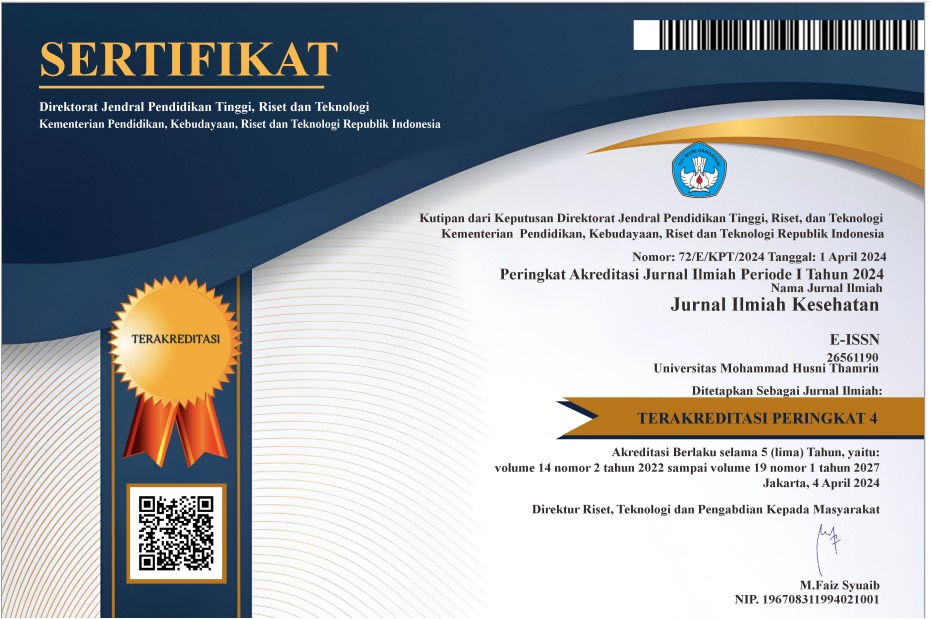Kesehatan Reproduksi Remaja Terkait Status Gizi, Aktifitas Fisik, Stres Dengan Siklus Menstruasi
DOI:
https://doi.org/10.37012/jik.v16i2.2478Keywords:
Keywords: Adolescent Reproductive Health, Menstrual Cycle, Nutritional Status, Physical Activity, StressAbstract
Abstract
The menstrual cycle is an important indicator of women's reproductive health (Omidvar et al., 2018). According to the research conducted at SMA Negeri 6 Tangerang, a higher proportion of irregular menstrual cycles was found, amounting to 59.4%. The impacts of irregular menstruation include infertility, endometriosis, and psychological disorders (Ilmi & Selasmi, 2019). The current target of the researchers is adolescents because adolescent reproductive health, especially regarding the menstrual cycle, is necessary for reproductive health readiness in adulthood.
The research method used is descriptive quantitative with a cross-sectional approach. The research respondents are high school students. The purpose of this study is to determine adolescent reproductive health related to nutritional status, physical activity, and anxiety with the menstrual cycle in high school.
The study results showed that the majority experienced irregular menstrual cycles, with 74 respondents (78.7%). The three variables studied, namely nutritional status, physical activity, and stress among high school students, showed no difference in proportion. This is because, during adolescence, the body adapts to hormonal changes during puberty, so the menstrual cycle still varies. This is considered normal. As age increases, the menstrual cycle will stabilize and become regular, especially after age 20 (Musmiah, 2018).
During data collection, it was found that respondents still did not understand how to calculate the menstrual cycle, so efforts are needed to increase knowledge and understanding of their menstrual cycles.
References
Ani, M. (2022). Manajemen Kesehatan Menstruasi (N. Sulung (ed.)). PT. Global Eksekutif Tekhnologi.
Botutihe, F. (2022). Aktifitas Fisik Dan Tingkat Stres Dengan Gangguan Pola Menstruasi. CV. Ruang Tentor.
Direktorat Promosi Kesehatan dan Pembayaran Masyarakat Kementrian Kesehatan RI. (2018). Pentingnya Menjaga Kebersihan Alat Reproduksi. Https://Promkes.Kemkes.Go.Id/. https://promkes.kemkes.go.id/pentingnya-menjaga-kebersihan-alat-reproduksi
Fatmayanti, A. (2022). Kesehatan Reproduksi Wanita (Oktavianis (ed.)).
Ilmi, A. F., & Selasmi, E. W. (2019). Faktor-Faktor Yang Berhubungan Dengan Siklus Menstruasi Pada Remaja Putri Kelas XI di SMA Negeri 6 Tangerang Selatan. Edu Masda Journal, 3(2), 175. https://doi.org/10.52118/edumasda.v3i2.39
Kansra, A. R., Lakkunarajah, S., & Jay, M. S. (2021). Childhood and Adolescent Obesity: A Review. Frontiers in Pediatrics, 8(January), 1–16. https://doi.org/10.3389/fped.2020.581461
Kemenkes RI. (2018). Laporan Riskesdas 2018 Kementrian Kesehatan Republik Indonesia. In Laporan Nasional Riskesdas 2018 (Vol. 53, Issue 9). http://www.yankes.kemkes.go.id/assets/downloads/PMK No. 57 Tahun 2013 tentang PTRM.pdf
Mannonovna, R. M. (2023). DISORDER OF THE MENSTRUAL CYCLE - CAUSES , SYMPTOMS , CLASSIFICATION , TREATMENT METHODS. 2(2), 31–37.
Meilan, N. (2019). Kesehatan Reproduksi Remaja Implementasi PKPR dalam Teman Sebaya. Wineka Media.
Peraturan Menteri Kesehatan RI Nomer 25 Tahun 2014 Tentang Upaya Kesehatan Anak, (2014).
Musmiah, S. B. (2018). Selamat Datang Masa Remaja. Deepublish.
Natalia, L. (2016). Gizi Dalam Kesehatan Reproduksi. Lovrinz Publising.
Omidvar, S., Amiri, F., Bakhtiari, A., & Begum, K. (2018). A study on menstruation of Indian adolescent girls in an urban area of South India. Journal of Family Medicine and Primary Care, 7(4), 698. https://doi.org/10.4103/jfmpc.jfmpc_258_17
Susilawati, D. (2019). HUBUNGAN OBESITAS DAN SIKLUS MENSTRUASI DENGAN KEJADIAN INFERTILITAS PADA PASANGAN USIA SUBUR DI KLINIK DR.HJ. PUTRI SRI LASMINI SpOG (K) PERIODE JANUARI-JULI TAHUN 2017. Jurnal Kesehatan Mercusuar, 2(1), 8. https://doi.org/10.36984/jkm.v2i1.20
Susilawati, E. (2022). Asuhan Kebidanan Pada Remaja Dan Perimenopause (R. Widyastuti (ed.)). Media Sains Indonesia.
Swarjana, I. K. (2022). Konsep Pengetahuan, Sikap, Prilaku, Presepsi, Stres, Kecemasan, Nyeri, Dukungan Sosial, Kepatuhan, Motivasi, Kepuasan, Pandemi Covid-19, Akses Layanan Kesehatan. Penerbit ANDI.
Wirenviona, R. (2020). Edukasi Kesehatan Reproduksi Remaja (R. I. Hariastuti (ed.)). Airlangga University Press.
Yolandiani, R. P., Fajria, L., & Putri, Z. M. (2020). Faktor – Faktor yang Mempengaruhi Ketidakteraturan Siklus Menstruasi Pada Remaja: Literatur Review. Jurnal Keperawatan Indonesia, 68(02), 1–10. http://scholar.unand.ac.id/id/eprint/67973
Yuliana, D., & Hernida. (2020). Hubungan Faktor Stres , Aktifitas Fisik dan Berat Badan dengan Kejadian Gangguan Siklus Menstruasi pada Remaja Putri Kelas XI di SMA Negeri 1 Sumber Rejo. Jurnal Ilmu Keperawatan Indonesia (JIKPI), 1(1), 1–9.
Downloads
Published
How to Cite
Issue
Section
Citation Check
License
Copyright (c) 2025 Dewi Suri Damayanti, Munawaroh

This work is licensed under a Creative Commons Attribution 4.0 International License.
Jurnal Ilmiah Kesehatan allows readers to read, download, copy, distribute, print, search, or link to the full texts of its articles and allow readers to use them for any other lawful purpose. The journal allows the author(s) to hold the copyright without restrictions. Finally, the journal allows the author(s) to retain publishing rights without restrictions Authors are allowed to archive their submitted article in an open access repository Authors are allowed to archive the final published article in an open access repository with an acknowledgment of its initial publication in this journal.

Lisensi Creative Commons Atribusi 4.0 Internasional.










